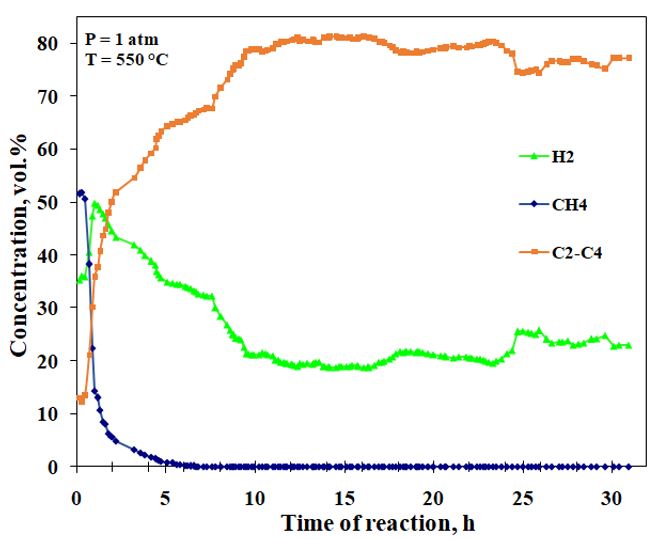
Decomposition of light hydrocarbons on a Ni-containing glass fiber catalyst
Abstract
Keywords
Full Text:
PDFReferences
Parkinson B, Tabatabaei M, Upham DC, Ballinger B, Greig C, Smart S, McFarland E. Hydrogen production using methane: Techno-economics of decarbonizing fuels and chemicals. Int J Hydrog Energy. 2018;43:2540–2555. doi:10.1016/j.ijhydene.2017.12.081
Qian JX et al. Methane decomposition to produce CO -free hydrogen and nano-carbon over metal catalysts: A review. 2020. Int J Hydrog Energy;45:7981–8001. doi:10.1016/j.ijhydene.2020.01.052
Global Hydrogen Review 2021. Int Energy Agency. 2021. https://iea.blob.core.windows.net/assets/3a2ed84c-9ea0-458c-9421-d166a9510bc0/GlobalHydrogenReview2021.pdf
Abbas HF, Wan Mohd WD. Hydrogen production by methane decomposition: A review. Int J Hydrog Energy. 2010;35:1160–1190. doi:10.1016/j.ijhydene.2009.11.036
Popov MV, Zazhigalov SV, Larina TV, Cherepanova SV, Bannov AG, Lopatin SA, Zagoruiko AN. Glass fiber supports modified by layers of silica and carbon nanofibers. Catalysis Sustain Energy. 2017;4(1):1–6.
Khudaish EA, Al-Badri A. A modified Hummers soft oxidative method for functionalization of CNTs: Preparation, characterization and potential application for selective determination of norepinephrine. Synth Met. 2021;277:116803. doi:10.1016/j.synthmet.2021.116803
Shibaev A, Yusin S, Maksimovskii E, Ukhina A, Bannov AG. Chemical treatment of graphite nanoplatelets and their use in supercapacitors. Russ J Appl Chem. 2016;89(5):739–745. doi:10.1134/S1070427216050098
Uvarov NF, Mateyshina YG, Ulihin A, Yusin S, Varentsova V, Varentsov V. Surface electrochemical treatment of carbon materials for supercapacitors. ECS Meet Abstr. 2009;37:2817–2817. doi:10.1149/1.3299286
Sysoev VI, Gusel’nikov AV, Katkov MV, Asanov IP, Bulusheva LG, Okotrub AV. Sensor properties of electron beam irradiated fluorinated graphite. J Nanophotonics. 2015;10:012512. doi:10.1117/1.jnp.10.012512
Rakow EG. Nanotubes and fullerens. M: Logos; 2006. 376 p.
Brester AE, Golovakhin VV, Novgorodtseva ON, Lapekin NI, Shestakov AA, Ukhina AV, et al. Chemically treated carbon nanofiber materials for supercapacitors. Dokl Chem. 2021;501:264–269. doi:10.1134/s0012500821120016
Bannov AG, Prášek J, Jašek O, Zajíčková L. Investigation of pristine graphite oxide as room-temperature chemiresistive ammonia gas sensing material. Sensors. 2017;17. doi:10.3390/s17020320
Liu S, Wang Z, Zhang Y, Zhang C, Zhang T. High performance room temperature NO2 sensors based on reduced graphene oxide-multiwalled carbon nanotubes-tin oxide nanoparticles hybrids. Sensors Actuators B Chem. 2015;211:318–324, doi:10.1016/j.snb.2015.01.127
Li L, He S, Liu M, Zhang C, Chen W. Three-dimensional mesoporous graphene aerogel-supported SnO2 nanocrystals for high-performance NO2 gas sensing at low temperature. Anal Chem. 2015;87:1638–1645. doi:10.1021/ac503234e
Baranov DV, Zagoruiko AN, Zazhigalov SV, Lopatin SA, Mikenin PE, Pisarev DA, Popov MV. Microfiber catalyst or carrier for catalysts and method for preparing the same. Patent RF 2624216. 2017 July 03.
Reshetenko TV, Avdeeva LB, Ismagilov ZR, Chuvilin AL, Ushakov VA. Applied Catalysis A: General. 2003;247:51–63.
Soloviov EA, Kuvshinov GG. Influence of the catalyst composition on the process of hydrogen production by selective catalytic pyrolysis of propane. Al’ternativnaya Energetika I Ekologiya. 2011;10:127–132.
Tursuniva NG, Musulmanov NKh, Faizullaev NI, Ikramov A. Obtaining nanocarbon and hydrogen by catalytic decomposition of low molecular weight hydrocarbons. Universum: khim. biol. 2023;103:43-52. Russian. doi:10.32743/UniChem.2023.103.1.14770
Zagoruiko AN, Bal'zhinimaev BS. Kataliticheskie protsessy na osnove steklovoloknistykh katalizatorov [Katalitichesky processes on the basis of glass-fiber catalysts]. Khimicheskaya promyshlennost' segodnya – Chemical Industry Today. 2011;2:5–11. Russian.
Zagoruiko AN, Lopatin SA, Bal’zhinimaev BS, Gil’mutdinov NR, Sibagatullin GG, Pogrebtsov VP, Nazmieva IF. The process for catalytic incineration of waste gas on IC-12-S102 platinum glass fiber catalyst. Catalysis Industry. 2010;2(2):113–117. doi:10.1134/S2070050410020042
Balzhinimaev BS, Paukshtis EA, Vanag SV, Suknev AP, Zagoruiko AN. Glass-fiber catalysts: Novel oxidation catalysts, catalytic technologies for environmental protection. Catalysis Today. 2010;151(1–2):195–199
Shinkarev VV, Glushenkov AM, Kuvshinov DG, Kuvshinov GG New effective catalysts based on mesoporous nanofibrous carbon for selective oxidation of hydrogen sulfide. Applied Catalysis B: Environmental. 2009;85:180–191. doi:10.1016/j.apcatb.2008.07.011
Kuvshinov DG, Kurmashov PB, Bannov AG, Popov MV, Kuvshinov GG. Synthesis of Ni-based catalysts by hexamethylenetetramine-nitrates solution combustion method for co-production of hydrogen and nanofibrous carbon from methane. Int J Hydrogen Energy. 2019;44(31):16271–16286. doi:10.1016/j.ijhydene.2019.04.179
DOI: https://doi.org/10.15826/chimtech.2023.10.3.06
Copyright (c) 2023 M.V. Popov, M.V. Chudakova, P.B. Kurmashov, A.G. Bannov, A.V. Kleimenov

This work is licensed under a Creative Commons Attribution 4.0 International License.
Chimica Techno Acta, 2014–2025
eISSN 2411-1414
Copyright Notice







